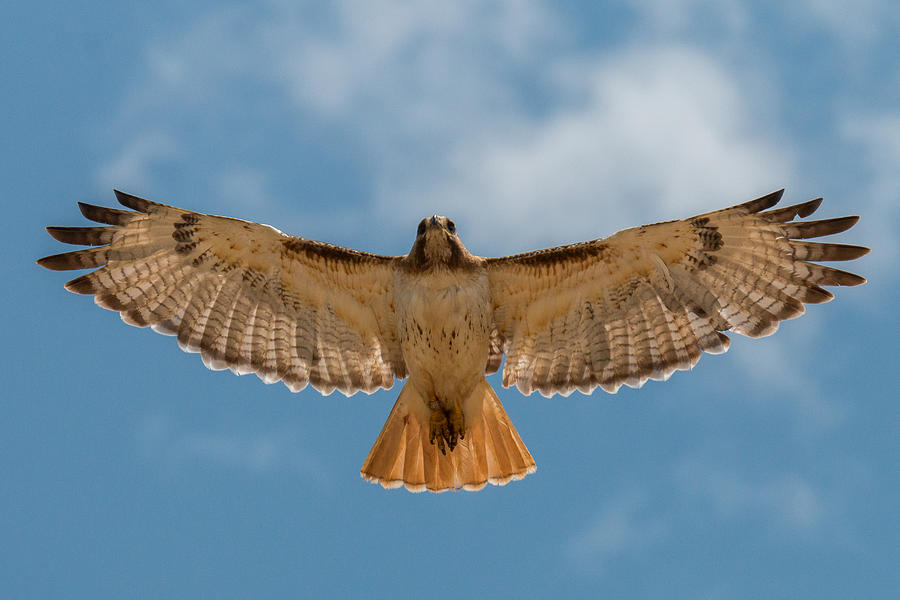



The relaxed Red-tailed Hawk foot and talon is closed. Then they hold their prey against a perch with their talons and use their beak to tear off pieces of meat. When hunting, the Red-tailed Hawk will use its talons to catch, subdue, and kill their prey. These act like the hawk’s knife and fork. Red-tailed Hawks have a sharply hooked beak and strong, curved talons. The lighter morph makes up almost all of the Red-tailed Hawks in eastern North America, while in the west there is much more variation. They are differentiated based on color morph and where they breed and spend the winter. There are at least 14 known subspecies of the Red-tailed Hawk, and as many as 16 depending on the source. Immature birds have lighter eyes and grayer tails and heavily streaked plumage. The cere, foot and leg are bright yellow. The breast and underbelly can range from a dark brown to a light buff color, with streaking on the belly, and the wings have a variable sized dark bar on the underside. The rest of their plumage varies greatly, though generally the back and wings are darker than the rest of the body, ranging from a light auburn to a dark brown. They can easily be identified by brick red tail feathers that give this bird its name. Juvenile Red-tailed hawks also tend to hunt from lower altitudes and hover rather than soar.The Red-tailed Hawk is a large hawk with broad wings. Red-tailed hawks diversify their diets to encompass trickier, faster-moving prey as they reach maturity. Prey are frequently seen squirming and trying to evade the grasp of juveniles’ talons, probably because they’re not as efficient as killing their prey as adults. Juvenile Red-tailed hawks target primarily voles, which are found to be the mainstay of their diet. Overall, juvenile Red-tailed hawks do not possess the same aerial competence as adults and may come across as clumsy in flight. Whereas adults spend much of their time soaring or perching on trees, juveniles fly at lower altitudes by flapping their wings rather than soaring. Juvenile Red-tailed hawks are not so confident in flight as adults. Conversely, juveniles are thinner with narrower tails. This is because their primary feathers are of greater length than juveniles, which gives them a broader profile in flight. Other differences between juvenile and adult Red-tailed hawks Silhouette and shapeĪdult Red-tailed hawks have a fuller silhouette. Paler juveniles have heavier brown wing speckles, which can turn almost completely white.ĭark morph juveniles look very similar to adults and are predominantly dark brown or cinnamon, and it’s harder to tell them apart from adults based on plumage alone.

White or light-coloured juvenile Red-tailed hawks may have speckly undersides, darker backs and pale heads. Young birds are still much smaller than adults at this stage, which makes them easier to identify.Īfter the young hawk starts to develop adult feathers, identification becomes a greater challenge. Red-tailed hawks moult and regrow their feathers most years, but the juveniles experience a major moult that sees them transition from their soft fledgling down to plumage that resembles an adult bird. This is true to an extent, but since Red-tailed hawk plumage is highly variable across the three main morphs and 13 subspecies, there is no one-size-fits-all method to identify a juvenile.įirstly, juvenile Red-tailed hawks are probably defined as post-first-moult birds. Juvenile Red-tailed hawks are generally described as scruffier, or duller than adults. What do juvenile Red-tailed hawks look like? Read on to learn more about juvenile Red-tailed hawks and further tips for identification! Since Red-tailed hawks can range from nearly all-white to dark brown or even black, differentiating juveniles often relies on comparing their size, shape and behaviour vs adults. This is the case across all subspecies and morphs. Light morph juveniles may have darker backs and speckly undersides, but plumage in other morphs is challenging to tell apart.Īnother reliable way to identify a juvenile Red-tailed hawk juvenile is by its iris, which is yellowish for around 1.5 years, then turning red-brown during adulthood. One of the main differences between juveniles and adults is that younger birds tend to have pale brownish tails with evenly spaced bars. There are 13 subspecies, too, so identifying juvenile Red-tailed hawks is a tricky procedure, to say the least - this guide to juvenile hawks will help! Red-tailed hawks are polymorphic, and individuals fall into three main morphs light, dark and intermediate. The elegant Red-tailed hawk ( Buteo jamaicensis) is the most widespread of all North American raptors and inhabits much of Canada and the USA. Other differences between juvenile and adult Red-tailed hawks


 0 kommentar(er)
0 kommentar(er)
